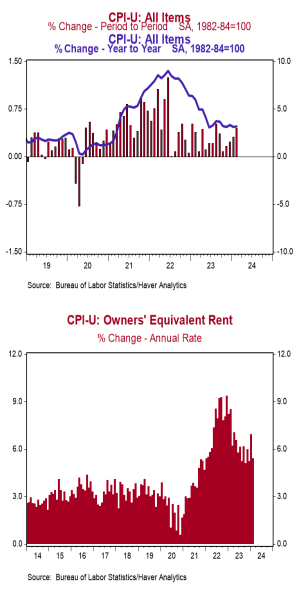- The Consumer Price Index (CPI) rose 0.4% in February, matching consensus expectations. The CPI is up 3.2% from a year ago.
- Energy prices rose 2.3% in February, while food prices were unchanged. The “core” CPI, which excludes food and energy, rose 0.4% in February, above the consensus expected +0.3%. Core prices are up 3.8% versus a year ago.
- Real average hourly earnings – the cash earnings of all workers, adjusted for inflation – declined 0.4% in February but are up 1.1% in the past year. Real average weekly earnings are up 0.5% in the past year.
Implications: Inflation accelerated in February, showing the battle against inflation is not over and the last mile of getting it back down to 2.0% will be the toughest. Looking at the headline, consumer prices rose 0.4% in January, the most in six months, while the twelve-month comparison ticked up to 3.2%. For those wondering, this marks the thirty-sixth straight month the year-to-year change is above the Fed’s 2.0% long term inflation target. Looking at the details, inflation was boosted by energy prices in February, which rose 2.3% on the back of higher prices for gasoline. However, it’s important to point out that energy has not been the culprit for stubbornly high inflation over the last year; energy prices are down 1.9% in the same timeframe. Stripping out the energy component and its often-volatile counterpart (food prices) to get “core” prices does not make the inflation picture look any better. That measure rose 0.4% in February for the second consecutive month, meaning January’s core jump was not a one-off anomaly. Rental inflation – both for actual tenants and the imputed rental value of owner-occupied homes – continue to defy predictions of imminent reversal, rising 0.4% for the month and running at or above a 5% annualized rate over three-, six-, and twelve-month timeframes. Housing rents have been a key driver of inflation over the last year (this month it was responsible for over a third of the rise in the overall index), and we expect it to continue to do so, as it makes up a third of the weighting in the overall index and still hasn’t caught up with the rise in home prices in the past four years. But the most troublesome piece of today’s report for the Federal Reserve came from movement in a subset category of prices that the Fed is watching closely – known as the “Super Core” – which excludes food, energy, other goods, and housing rents, and is a useful gauge of inflation in the services sector. After jumping 0.8% in January, that measure followed up with a 0.5% increase in February, driven by higher prices for airfare (+3.6%) and motor vehicle insurance (+0.9%). In the last twelve months, this measure is up 4.3% and has been accelerating as of late; up at 6.9% and 5.9% annualized rates in the last three and six months, respectively. And while inflation remains stubbornly high, workers are no longer being compensated for it. Case in point, real average hourly earnings declined 0.4% in February. These earnings are up 1.1% in the past year, while real average weekly earnings are up just 0.5%, underpinning brewing weakness in the labor market. Putting this all together, the Fed has little reason at this point to start cutting rates soon. How they respond to the incoming economic data in the months ahead could determine whether we repeat the inflationary 1970s





